Using Location Quotients to Determine Public–Natural Space Spatial Patterns: A Zurich Model
Abstract
:1. Introduction
2. The Restrictive/Dependent Relationship between the Layout of Urban Public Space and Natural Factors
2.1. The Overlapping Mode
2.2. The Separation Mode
2.3. The Edge-Binding Mode
3. Methodology
3.1. The Location Quotient Method
3.2. The Framework of Quantitative Calculation
3.2.1. Establishing a Vectorized Digital Base Map
3.2.2. LQ Application and Index Selection
3.2.3. Data Statistics and Analysis
4. Case Study
4.1. An Overview of the Natural Factor Distribution and Public Space Pattern of Zurich
4.2. The Quantification of Relationship Modes
5. Results
5.1. The Layout Relationship between Public Space and Natural Factors Based on the Layer Structure
5.1.1. The Overlapping Relationship
5.1.2. The Separation Relationship
5.1.3. The Edge-Binding Relationship
5.2. The Layout Relationship between Public Space and Natural Factors Based on Administrative District Units
6. Discussion and Analysis
7. Conclusions
Author Contributions
Funding
Acknowledgments
Conflicts of Interest
References
- Xu, X.; Wang, J. Research into the ecological strategy of green urban design based on bioclimatic conditions: The case of urban design in wet and hot regions. Archit. J. 2007, 463, 64–67. [Google Scholar]
- Waldheim, C. (Ed.) The Landscape Urbanism Reader; Princeton Architectural Press: New York, NY, USA, 2006. [Google Scholar]
- Yang, R.; Yuan, L.; Zheng, X. Relationship between landscape architecture and urban design. Chin. Landsc. Archit. 2016, 243, 37–42. [Google Scholar]
- McHarg, I.L. Design with Nature, 25th Anniversary ed.; John Wiley & Sons, Inc.: New York, NY, USA, 1995. [Google Scholar]
- Beveridge, C.E.; Rocheleau, P. Frederick Law Olmsted: Designing the American Landscape; Rizzoli: New York, NY, USA, 1998. [Google Scholar]
- Starke, B.; Simonds, J.O. Landscape Architecture: A Manual of Environmental Planning and Design, 5th ed.; McGraw-Hill Education: San Francisco, CA, USA, 2013. [Google Scholar]
- Carr, S.; Francis, M.; Rivlin, L.G.; Stone, A.M. Public Space; Cambridge University Press: New York, NY, USA, 1992. [Google Scholar]
- Freedom to Roam. Available online: http://en.wikipedia.org/wiki/Allemansr%C3%A4tten (accessed on 28 September 2018).
- Planning Policy Guidance 17: Planning for Open Space, Sport and Recreation. Available online: http://webarchive.nationalarchives.gov.uk/20120920042539/http://www.communities.gov.uk/documents/planningandbuilding/pdf/ppg17.pdf (accessed on 27 September 2018).
- Zhu, B.; Zhang, J.; Tzeng, G.; Huang, S.; Xiong, L. Public open space development for elderly people by using the DANP-V model to establish continuous improvement strategies towards a sustainable and healthy aging society. Sustainability 2017, 9, 420. [Google Scholar] [CrossRef]
- Christian, N.S. Towards a Phenomenology of Architecture; Rizzoli: New York, NY, USA, 1980. [Google Scholar]
- Littke, H. Planning the green walkable city: Conceptualizing values and conflicts for urban green space strategies in Stockholm. Sustainability 2015, 7, 11306–11320. [Google Scholar] [CrossRef]
- Maas, J.; Verheij, R.A.; Groenewegen, P.P.; Vries, S.; Spreeuwenberg, P. Green space, urbanity, and health: How strong is the relation? J. Epidemiol. Community Health 2006, 60, 587–592. [Google Scholar] [CrossRef] [PubMed]
- Trinkley, M.; Hacker, D. Tranquil Hill Plantation: The Most Charming Inland Place; Chicora Foundation, Inc.: Columbia, SC, USA, 2008. [Google Scholar]
- Corner, J. Recovering Landscape; Princeton Architectural Press: New York, NY, USA, 2006. [Google Scholar]
- Czerniak, J.; Hargreaves, G. Large Parks; Princeton Architectural Press: New York, NY, USA, 2007. [Google Scholar]
- Jacobs, J. The Death and Life of Great American Cities; Random House: New York, NY, USA, 1961. [Google Scholar]
- Wu, J. Landscape Ecology: Patterns, Processes, Scales and Levels; Higher Education Press: Beijing, China, 2000. [Google Scholar]
- Gehl, J. Cities for People; Island Press: Washington, DC, USA, 2010. [Google Scholar]
- Hough, M. Cities and Natural Process: A Basis for Sustainability, 2nd ed.; Routledge: New York, NY, USA, 2004. [Google Scholar]
- Southworth, M. New urbanism and the American metropolis. Built. Environ. 2003, 29, 210–226. [Google Scholar] [CrossRef]
- Xu, X.; Xu, X.; Guan, P.; Ren, Y.; Wang, W.; Xu, N. The Cause and Evolution of Urban Street Vitality under the Time Dimension: Nine Cases of Streets in Nanjing City, China. Sustainability 2018, 10, 2797. [Google Scholar] [CrossRef]
- Hillier, B.; Hanson, J. The Social Logic of Space; Cambridge University Press: London, UK, 1984. [Google Scholar]
- Marshall, S. Streets and Patterns; Spon Press: Abingdon, UK, 2005. [Google Scholar]
- Lee, C.; Moudon, A.V. The 3Ds + R: Quantifying land use and urban form correlates of walking. Transp. Res. Part D 2006, 11, 204–215. [Google Scholar] [CrossRef]
- Ståhle, A. Compact Sprawl: Exploring Public Open Space and Contradictions in Urban Density; Royal Institute of Technology: Stockholm, Sweden, 2008. [Google Scholar]
- Ahern, J. Planning for an extensive open space system: Linking landscape structure and function. Landsc. Urban Plan. 1991, 21, 131–145. [Google Scholar] [CrossRef]
- Xu, X.; Liu, J.; Xu, N.; Wang, W.; Yang, H. Quantitative Study on the Evolution Trend and Driving Factors of Typical Rural Spatial Morphology in Southern Jiangsu Province, China. Sustainability 2018, 10, 2392. [Google Scholar] [CrossRef]
- Haggett, P. Locational Analysis in Human Geography; Edward Arnold: London, UK, 1965. [Google Scholar]
- Cui, G.; Wei, Q.; Chen, Z. Regional Analysis and Planning; Higher Education Press: Beijing, China, 1999. [Google Scholar]
- Xu, N. A Study on the Pattern of Urban Public Space Based on Efficiency and Equity. Archit. J. 2018, 6, 16–22. [Google Scholar]
- Park, R.E.; Burgess, E.W.; McKenzie, R.D. The City; The University of Chicago Press: Chicago, IL, USA, 1967. [Google Scholar]
- Stadt Zürich. Stadträume 2010: Strategie für die Gestaltung von Zürichs öffentlichem Raum; Druckerei Kyburz: Dielsdorf, Switzerland, 2006. [Google Scholar]
- Quartierspiegel - Über 1000 Seiten Information zu Zürichs Quartieren. Available online: https://www.stadt-zuerich.ch/prd/de/index/statistik/publikationen-angebote/publikationen/Quartierspiegel.html (accessed on 30 June 2015).
- Xu, N. The Pattern and the Evaluation Research of Urban Public Space Based on Efficiency and Equity Perspectives; Southeast University: Nanjing, China, 2013. [Google Scholar]
- Gao, Z. The management system of spatial planning in Switzerland and thoughts giving to China. Urban Plan. Int. 2009, 24, 84–92. [Google Scholar]
- Zonenpläne Online. Available online: https://www.maps.stadt-zuerich.ch/zueriplan3/Katasterauskunft.aspx?#route_visible=true&basemap=BZO%3A+Zonenplan&map=&scale=64000&xkoord=2680809.802742748&ykoord=1248329.46245527&lang=&layer=Liegenschaft%3A%3A0&window=&selectedObject=CH667099913801&selectedLayer=&toggleScreen=2&legacyUrlState=&drawings= (accessed on 28 September 2018).
- Park, S. A preliminary study on connectivity and perceived values of community green spaces. Sustainability 2017, 9, 692. [Google Scholar] [CrossRef]
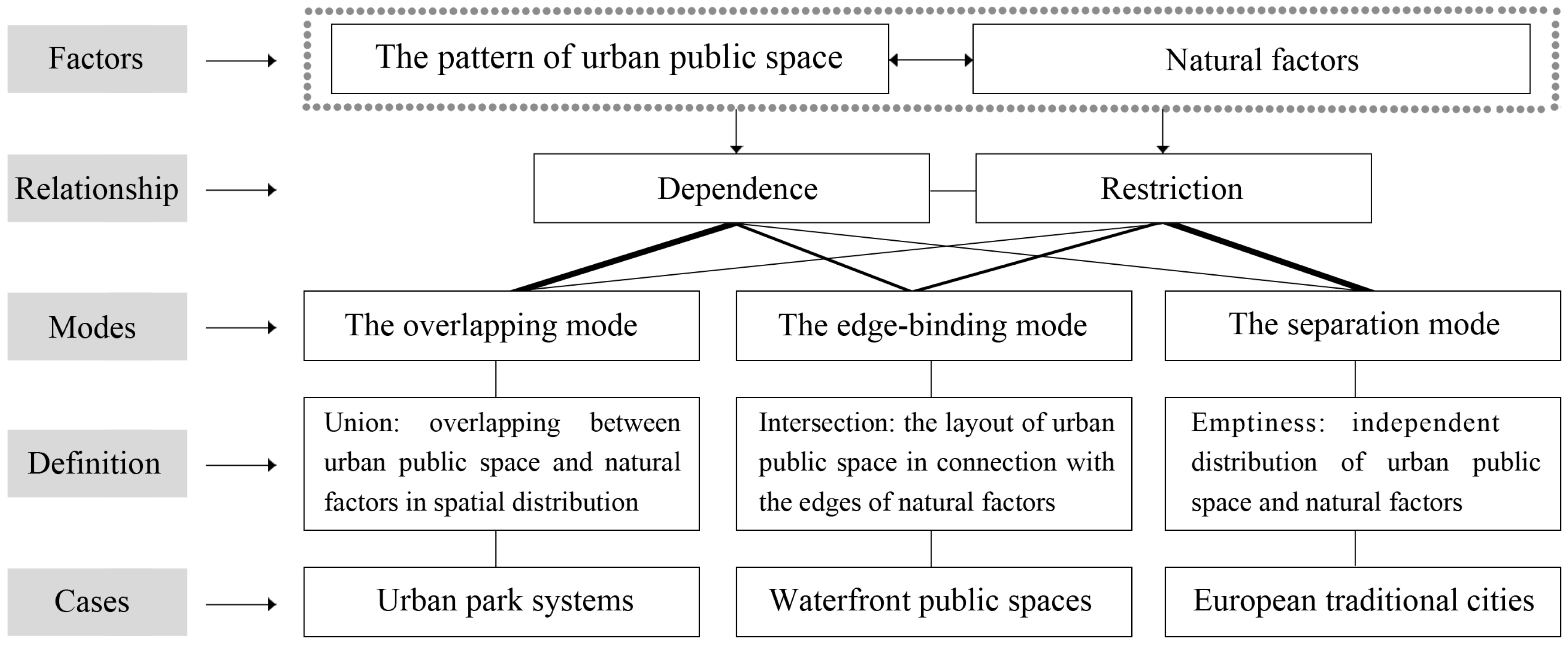
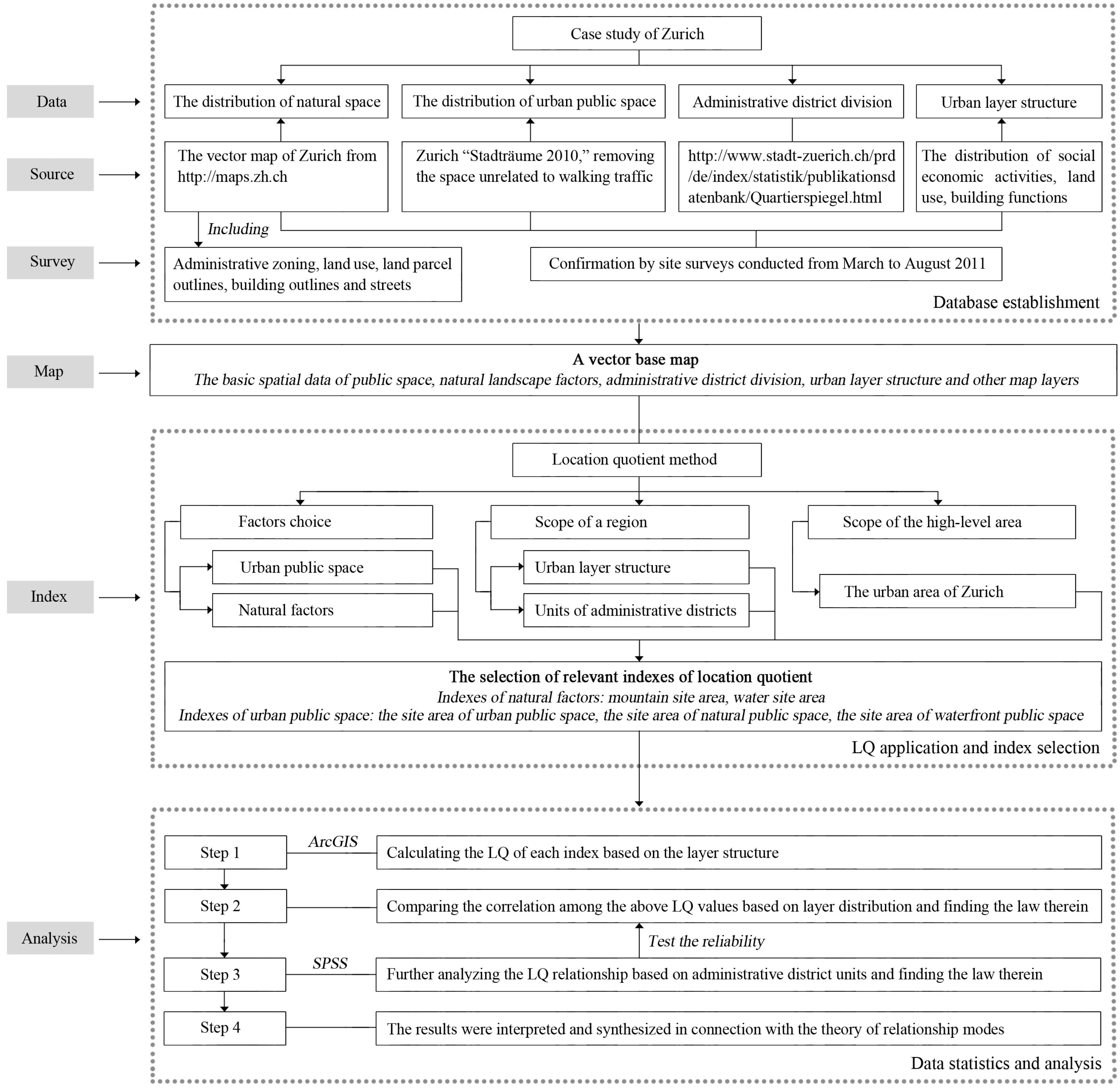
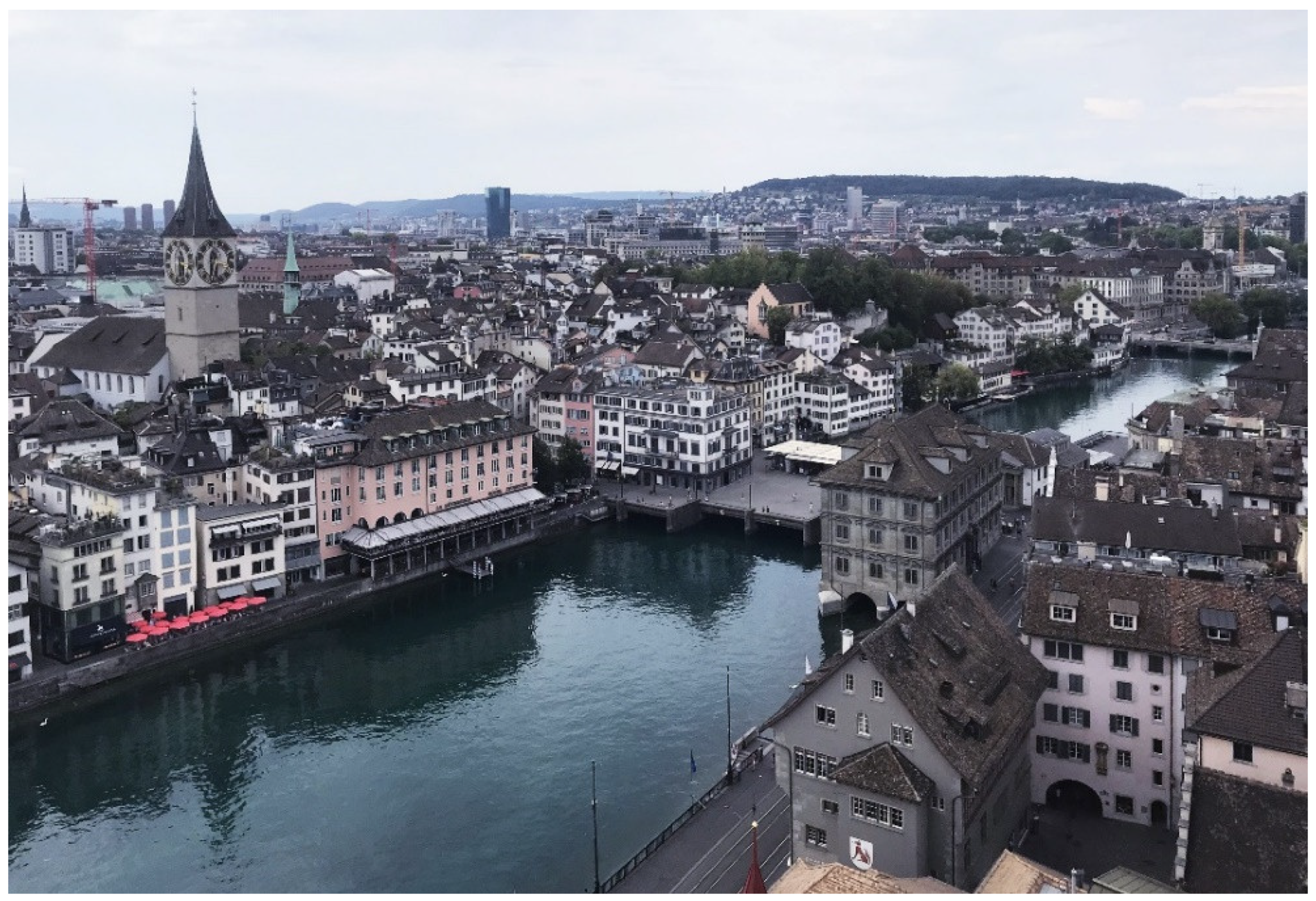
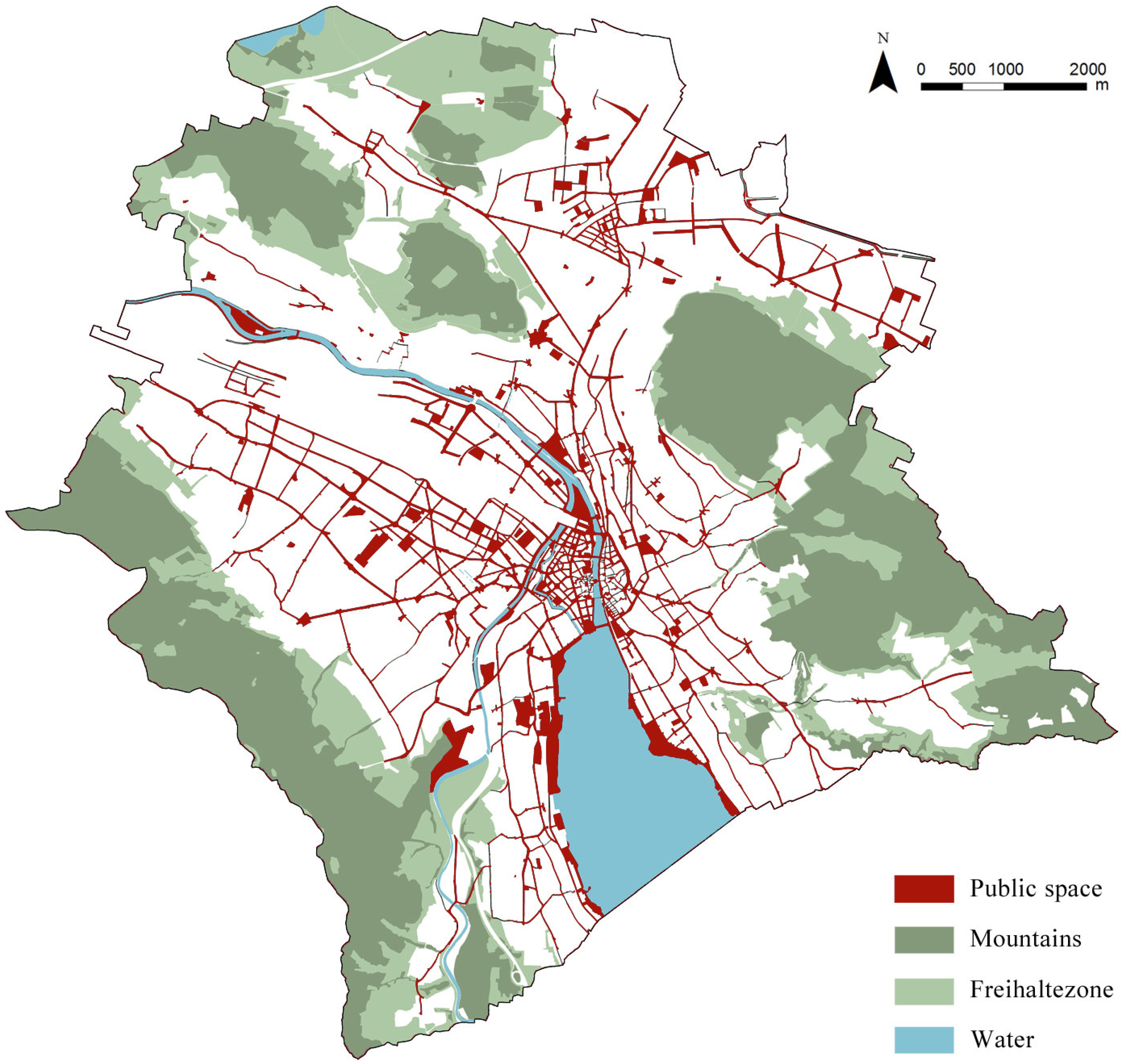
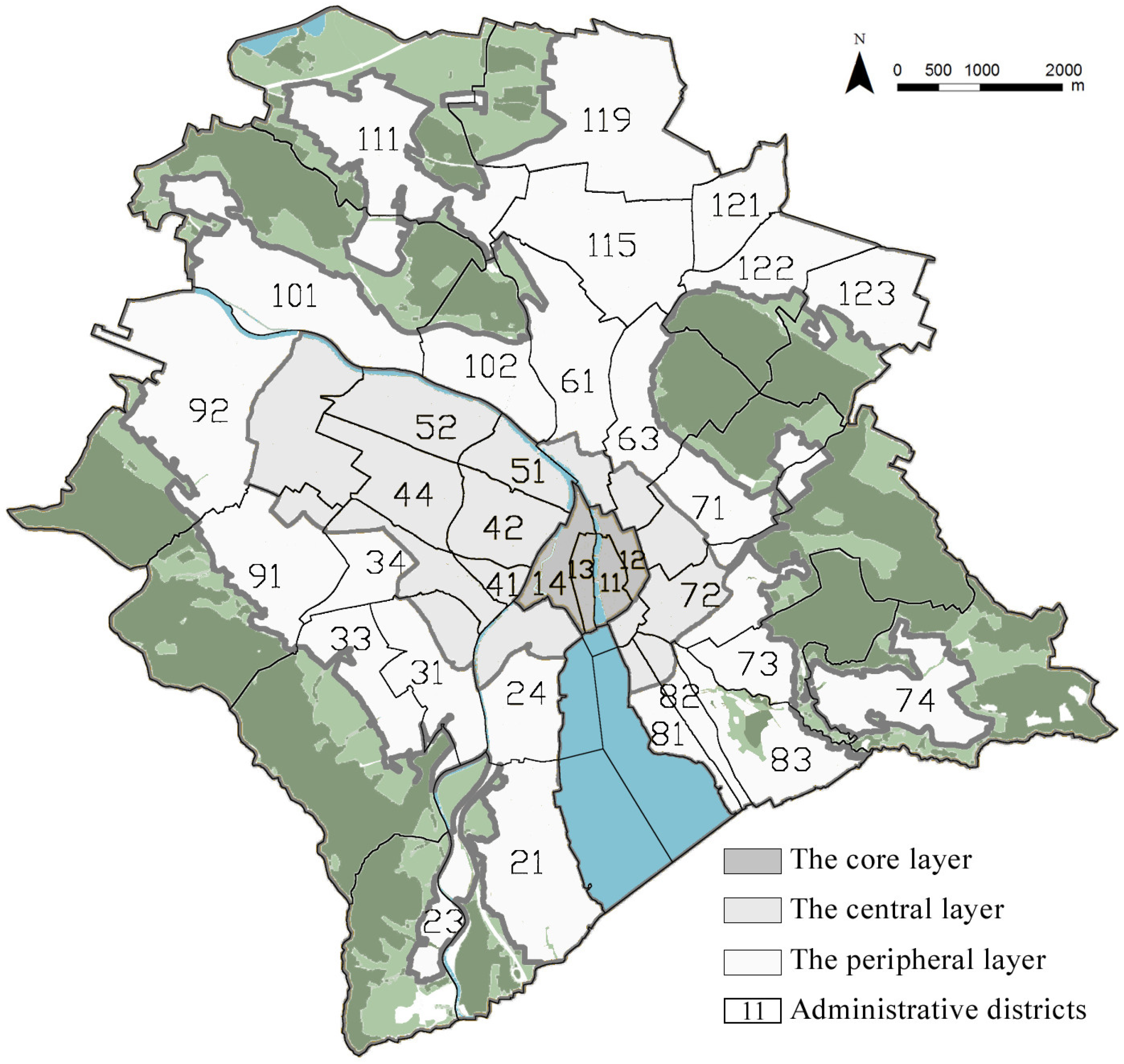

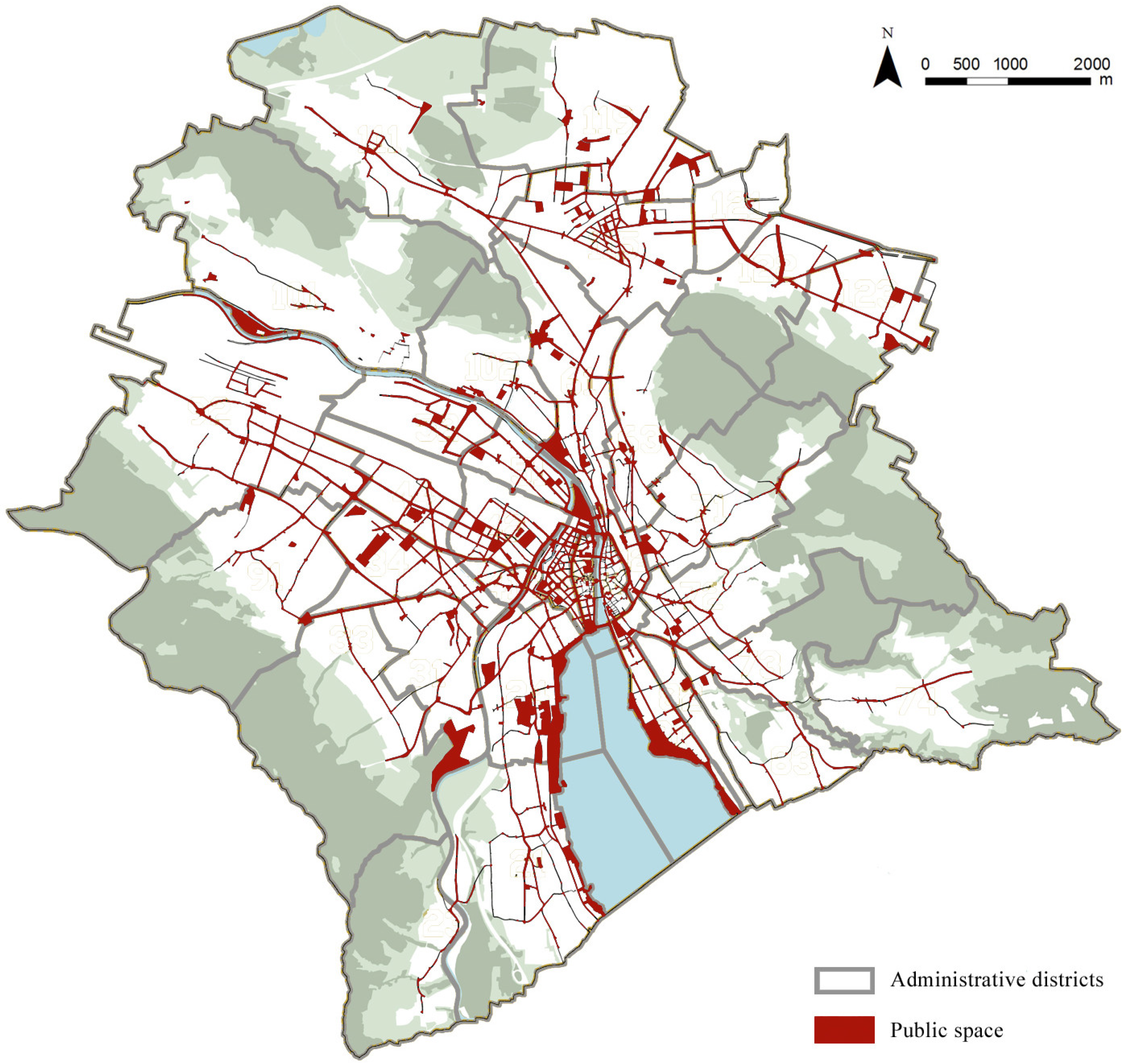
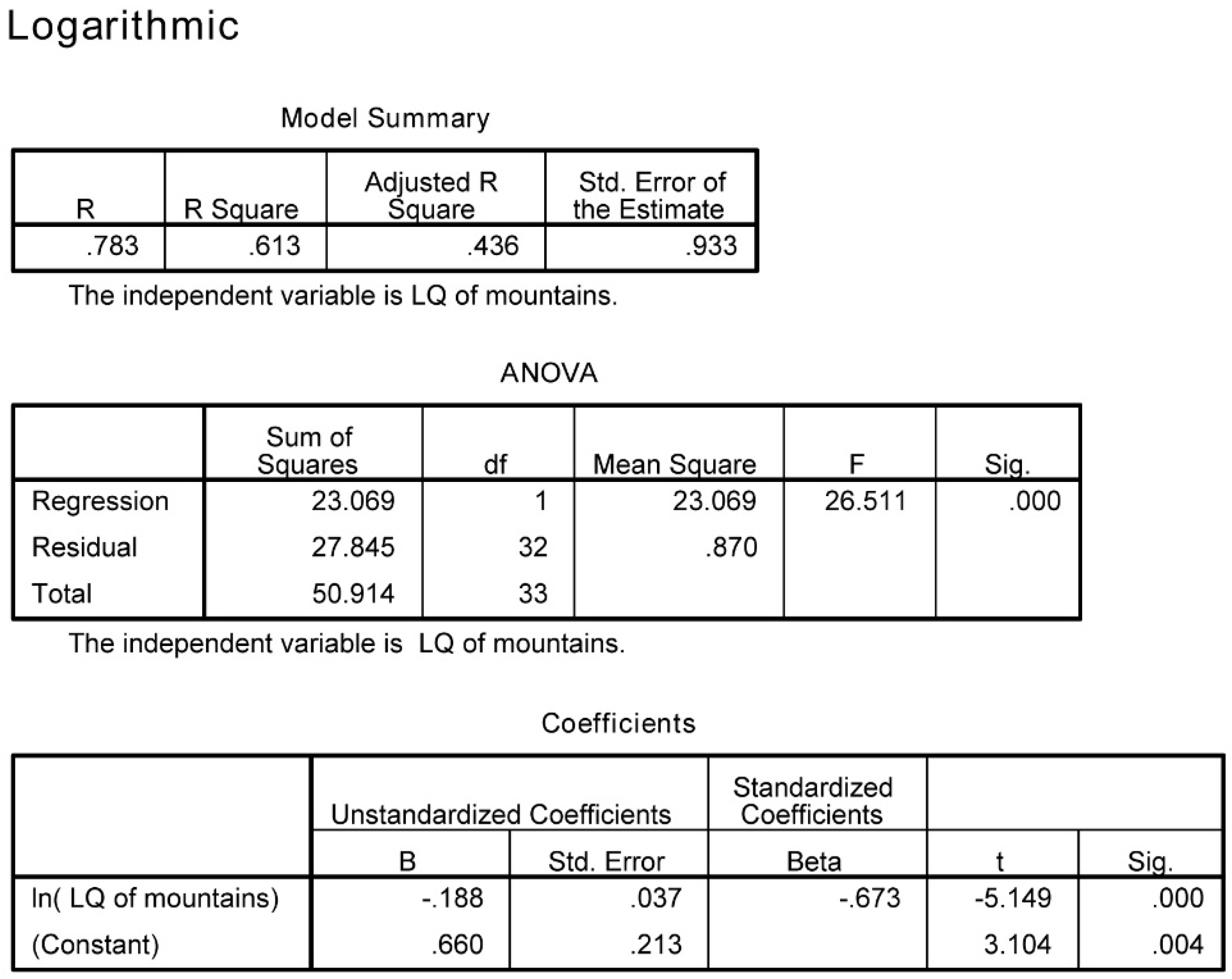
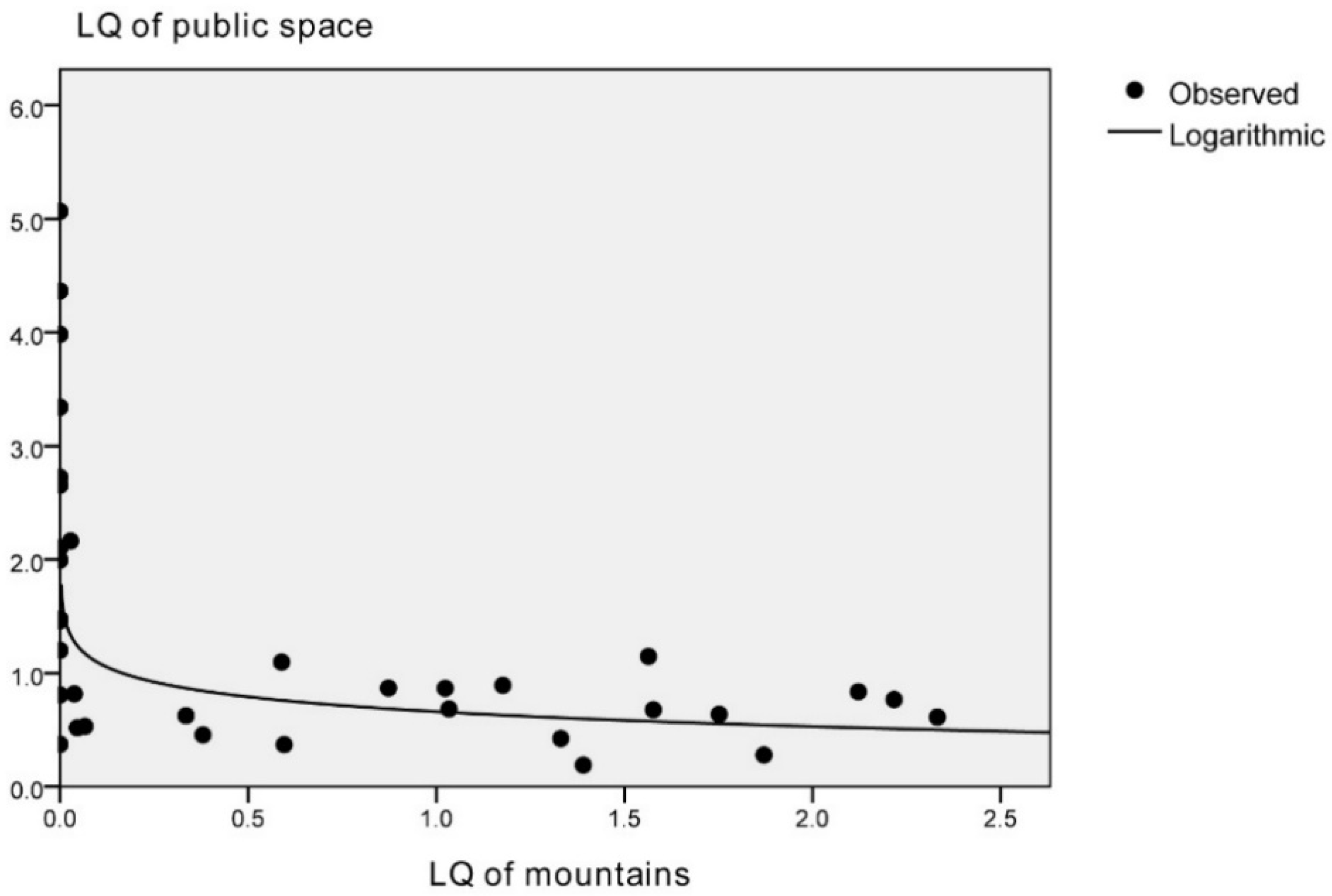
| The Overlapping Mode | |
| Layout | Union: urban public space and natural factors overlap in spatial distribution |
| Advantages | Ecology: natural factors play the ecological role, and urban textures are incorporated into the regional and biological background Aesthetics: large natural factors become the carrier of cognition of urban features, bring landscape benefits, and improve urban quality [20] Health: natural factors help regulate citizens’ physical and mental health |
| Challenges | Society: enhancement of diversity and inclusiveness characteristics of natural spaces [13] Density: density of urban textures declines Structure: large natural factors lead to separation of urban space |
| The Separation Mode | |
| Layout | Emptiness: independent layout between urban public space and natural factors |
| Advantages | Purity: both the priority of the ecosystem and the “urbanity” of the city are guaranteed Fairness: fairness in the pattern of public space and distribution of natural factors Vigor: suitable for cities with a centralized layout, providing easier social contact [21,22] |
| Challenges | Ecology: decrease of natural space inside the city Connection: isolation between public space layout and natural factors Dispersion: decline of accessibility to natural factors |
| The Edge-Binding Mode | |
| Layout | Intersection: combine urban public space with natural factors at the edge zone |
| Advantages | High efficiency: public space uses natural resources to provide activity support, and the natural landscape is reinforced Structure: Intervening in the urban structure, playing an active role in urban life Development: a strong “edge effect”, facilitating the appreciation of neighboring land and boosting regional economic development |
| Challenges | Fairness: public space around natural environment is threatened by privatization Vigor: the public space adjacent to the natural resources, on the periphery of the city, has declining accessibility and service objects |
| Index | di/Di | ||
|---|---|---|---|
| Indexes of natural factors | Mountain site area | The site area of different layers/the site area of different administrative districts | The site area of Zurich |
| Water site area | |||
| The indexes of urban public space | The site area of urban public space | ||
| The site area of natural public space | |||
| The site area of waterfront public space |
| Layer | Spatial Scope | Area (km2) | Proportion |
|---|---|---|---|
| Core layer | Old urban area | 1.5 | 1.7% |
| Central layer | Focused on public areas (the hinterlands of Limmat and railway station yards, and the neighborhoods of Zurich Lake) | 11.7 | 12.7% |
| Peripheral layer | Focused on residential areas (the district boundary, deducting the core layer and central layer) | 78.7 | 85.6% |
| Total city | The boundary of administrative districts | 91.9 | 100% |
| Structure | Mountain Bodies | Water Bodies | Natural Public Space | Waterfront Public Space | Urban Public Space |
|---|---|---|---|---|---|
| The core layer | 0.000 | 1.555 | 3.576 | 6.194 | 5.796 |
| The central layer | 0.005 | 0.530 | 1.867 | 1.556 | 2.270 |
| The peripheral layer | 1.167 | 1.059 | 0.820 | 0.815 | 0.717 |
| Average | 0.391 | 1.048 | 2.088 | 2.855 | 2.928 |
| Standard deviation | 0.549 | 0.418 | 1.136 | 2.381 | 2.125 |
| Variable coefficient | 1.405 | 0.399 | 0.544 | 0.834 | 0.726 |
| Administrative Districts | Mountain Bodies | Public Space | Administrative Districts | Mountain Bodies | Public Space |
|---|---|---|---|---|---|
| 11 | 0.000 | 3.342 | 73 | 2.332 | 0.612 |
| 12 | 0.000 | 3.983 | 74 | 1.391 | 0.190 |
| 13 | 0.000 | 4.365 | 81 | 0.000 | 2.655 |
| 14 | 0.000 | 5.066 | 82 | 0.000 | 0.373 |
| 21 | 0.589 | 1.097 | 83 | 0.380 | 0.456 |
| 23 | 1.871 | 0.279 | 91 | 1.752 | 0.637 |
| 24 | 0.000 | 2.163 | 92 | 0.873 | 0.868 |
| 31 | 0.066 | 0.531 | 101 | 1.331 | 0.424 |
| 33 | 2.122 | 0.836 | 102 | 1.034 | 0.684 |
| 34 | 0.000 | 1.476 | 111 | 0.596 | 0.370 |
| 41 | 0.000 | 2.723 | 115 | 0.038 | 0.817 |
| 42 | 0.000 | 2.104 | 119 | 0.335 | 0.625 |
| 44 | 0.000 | 1.200 | 121 | 0.046 | 0.518 |
| 51 | 0.000 | 1.995 | 122 | 1.577 | 0.677 |
| 52 | 0.000 | 0.808 | 123 | 1.177 | 0.892 |
| 61 | 0.000 | 1.462 | Average | 0.657 | 1.383 |
| 63 | 1.564 | 1.147 | Standard deviation | 0.779 | 1.224 |
| 71 | 1.024 | 0.866 | Variable coefficient | 1.185 | 0.885 |
| 72 | 2.217 | 0.767 |
© 2018 by the authors. Licensee MDPI, Basel, Switzerland. This article is an open access article distributed under the terms and conditions of the Creative Commons Attribution (CC BY) license (http://creativecommons.org/licenses/by/4.0/).
Share and Cite
Xu, N.; Cheng, Y.; Xu, X. Using Location Quotients to Determine Public–Natural Space Spatial Patterns: A Zurich Model. Sustainability 2018, 10, 3462. https://doi.org/10.3390/su10103462
Xu N, Cheng Y, Xu X. Using Location Quotients to Determine Public–Natural Space Spatial Patterns: A Zurich Model. Sustainability. 2018; 10(10):3462. https://doi.org/10.3390/su10103462
Chicago/Turabian StyleXu, Ning, Yuning Cheng, and Xiaodong Xu. 2018. "Using Location Quotients to Determine Public–Natural Space Spatial Patterns: A Zurich Model" Sustainability 10, no. 10: 3462. https://doi.org/10.3390/su10103462
APA StyleXu, N., Cheng, Y., & Xu, X. (2018). Using Location Quotients to Determine Public–Natural Space Spatial Patterns: A Zurich Model. Sustainability, 10(10), 3462. https://doi.org/10.3390/su10103462





